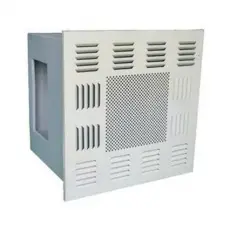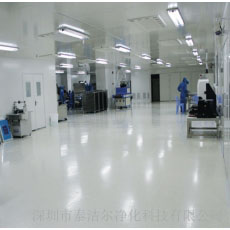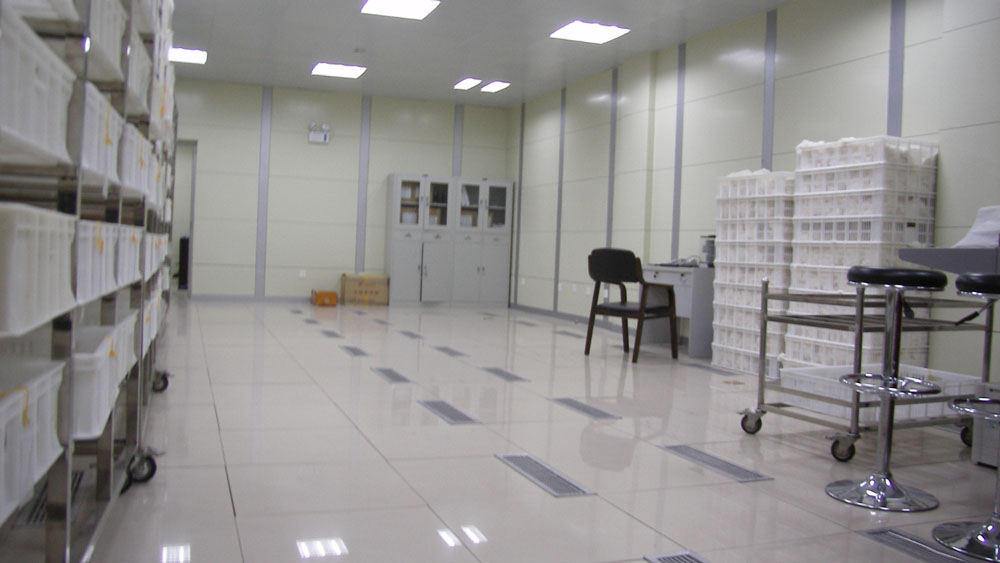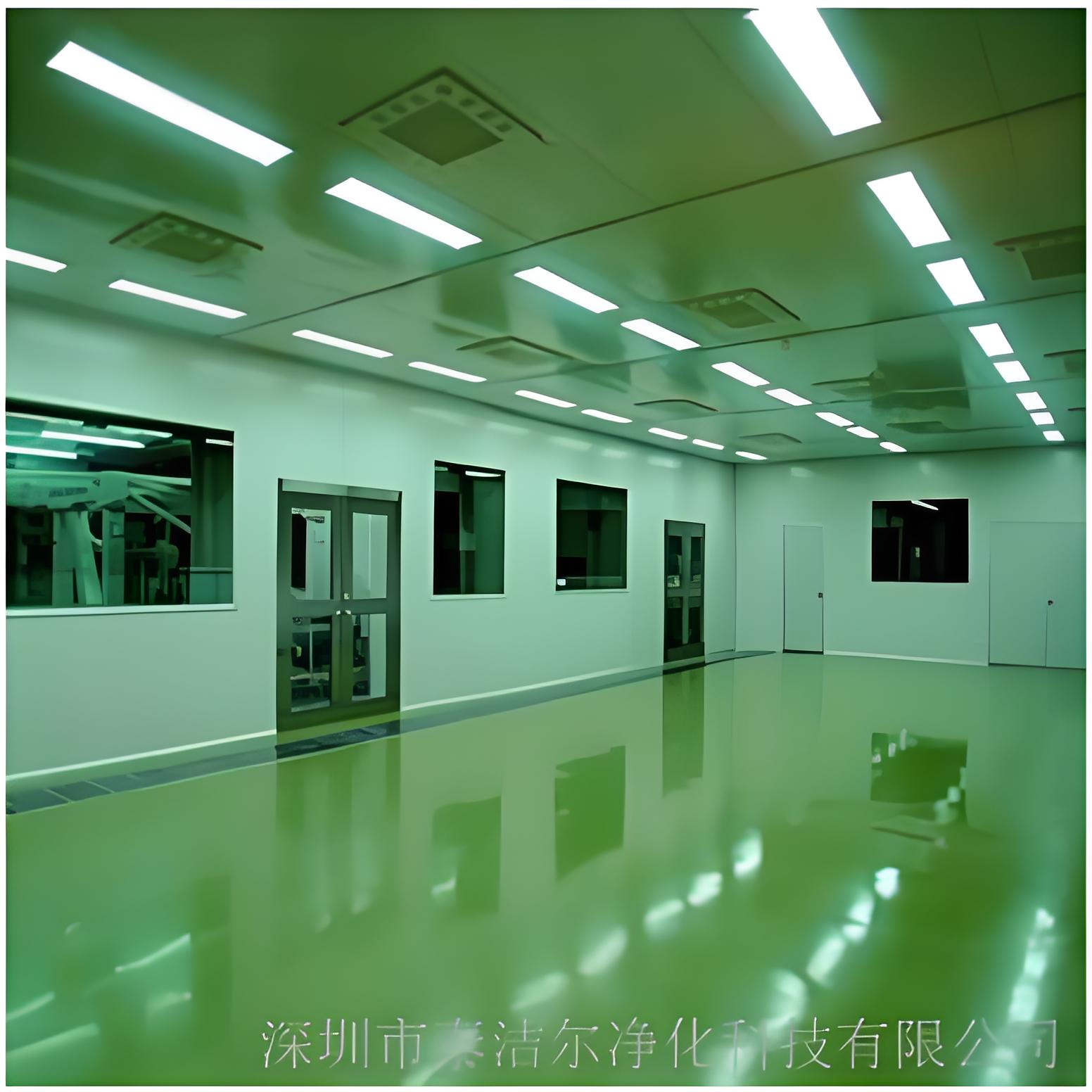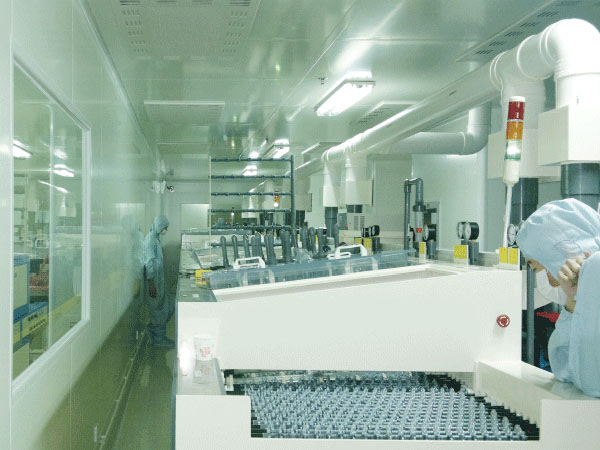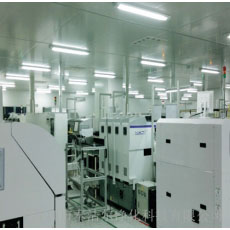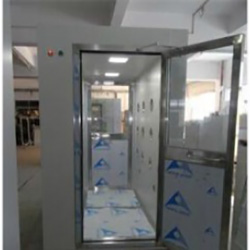




1. Air shower room:
The air shower room is an essential cleaning device for personnel entering cleanrooms. It has high applicability and can be combined with all types of cleanrooms and clean factories. When personnel enter the room, they must pass through this device where strong clean air is sprayed from multi-directional rotating nozzles onto their bodies, effectively and quickly removing dust, hair, dandruff, and other contaminants from clothing. It helps minimize contamination issues when people enter and exit the cleanroom. The air shower room's two doors feature interlocking electronic locks and can function as an airlock, preventing external contamination and unfiltered air from entering the clean area. This ensures strict dust-free standards in the work area, enabling the production of high-quality products.
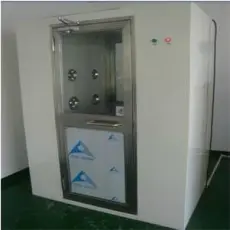
2. Pass-through window:
Pass-through windows are divided into standard pass-through windows and air shower pass-through windows. Standard pass-through windows are mainly used for transferring items between clean and non-clean areas, reducing door openings, and serving as the best cleaning device to minimize cross-contamination between clean and non-clean areas. The windows feature dual interlocking mechanisms (meaning only one door can be opened at a time).
Pass-through windows can be categorized by material: stainless steel pass-through windows, steel-exterior/stainless steel-interior pass-through windows, etc. They can also be equipped with UV sterilization lamps (8W), internal communication systems, etc.
3. Air shower pass-through window:
The air shower pass-through window is an auxiliary device for cleanrooms. To reduce large amounts of dust particles caused by material transfer, clean air passing through high-efficiency filters is sprayed from multi-directional rotating nozzles onto items, effectively and quickly removing dust particles. After cleaning, the dust particles are filtered through primary and high-efficiency filters before recirculating to the air shower area. For optimal air shower effects, the wind speed at the nozzle outlet can exceed 20 seconds.
(1) Air shower pass-through windows can be categorized by structure: vertical air shower pass-through windows and floor-type air shower pass-through windows;
(2) Air shower pass-through windows can be categorized by material: stainless steel air shower pass-through windows, steel-exterior/stainless steel-interior air shower pass-through windows (all interior surfaces are matte stainless steel);
(3) Air shower pass-through windows can be categorized by interlocking method: electronic interlocking air shower pass-through windows and mechanical interlocking air shower pass-through windows.
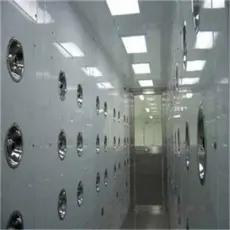
FFU stands for Fan Filter Unit and features modular connectivity. It has two filtration stages: primary and high-efficiency. The working principle involves: air being drawn into the FFU from above and filtered through primary and high-efficiency filters, then clean air is evenly distributed through the outlet surface at an average wind speed of 0.45m/s. FFUs have lightweight designs compatible with various grid systems and can even adjust structural dimensions according to grid systems. Internal diffuser plates help evenly distribute wind pressure, creating stable and uniform wind speeds at the outlet. The internal metal structure never ages, preventing secondary contamination, with smooth surfaces, low wind resistance, and good sound insulation. The unique air inlet duct design reduces pressure loss and noise. High efficiency, low power consumption, and energy savings. Single-phase motors offer three speed levels for adjustable wind speed and airflow. Depending on customer requirements, single units or mass-produced connected units can be used, with control options like electronic speed control panels, step adjustment, or centralized computer control, featuring energy savings, stable operation, low noise, digital adjustment, etc. Widely used in electronics, optics, defense, laboratories, hospitals, and other areas requiring air cleanliness. Additionally, they can be combined with support frames and anti-static curtains to create clean workstations of Class 100-300,000 in various sizes, ideal for building small clean areas cost-effectively.
(1) FFU cleanliness level: Static Class 100;
(2) FFU wind speed: 0.3/0.35/0.4/0.45/0.5m/s, FFU noise ≤46dB, FFU power supply: 220V, 50Hz;
(3) FFU uses partitionless high-efficiency filters, with FFU filtration efficiency at 99.99%, ensuring cleanliness standards;
(4) Entire FFU made from high-quality galvanized aluminum sheets;
(5) FFU features stepless speed control design, stable speed regulation, maintaining constant airflow even when high-efficiency filters reach final resistance;
(6) FFU uses high-efficiency centrifugal fans, long lifespan, low noise, maintenance-free, minimal vibration;
(7) FFU is particularly suitable for assembling ultra-clean production lines, either used individually or combined to form Class 100 assembly lines.
5. Laminar flow hood:
Laminar flow hoods mainly include housings, fans, high-efficiency air filters, primary filters, perforated plates, and control systems. The exterior can be powder-coated galvanized steel or stainless steel. Laminar flow hoods direct air through high-efficiency filters at specific speeds, creating uniform laminar flow for vertical unidirectional clean airflow, ensuring work areas meet high cleanliness requirements. These are localized clean air units that can be flexibly installed at process points requiring high cleanliness. Laminar flow hoods can be used singly or combined to form strip clean areas. They can be ceiling-mounted or floor-standing, with compact structures for convenient use.
(1) Laminar flow hood cleanliness: Static Class 100, work area with ≤3.5 particles/liter for particles ≥0.5μm (FS209E Class 100);
(2) Average laminar flow hood wind speed: 0.3-0.5m/s, noise ≤64dB, power supply: 220V, 50Hz;
(3) Laminar flow hood uses partitionless high-efficiency filters, filtration efficiency 99.99%, ensuring cleanliness;
(4) Entire laminar flow hood made from high-quality powder-coated galvanized steel, aluminum, or stainless steel sheets;
(5) Laminar flow hood control: stepless speed control or electronic speed control panel, stable speed regulation, maintaining constant airflow even when high-efficiency filters reach final resistance;
(6) Laminar flow hood uses high-efficiency centrifugal fans, long lifespan, low noise, maintenance-free, minimal vibration;
(7) Laminar flow hood is particularly suitable for assembling ultra-clean production lines, either used individually per process needs or combined to form Class 100 assembly lines
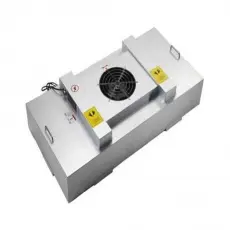
6. Clean workbench:
Clean workbenches are divided into vertical flow and horizontal flow types. This is a prioritized cleaning device for improving process conditions and ensuring cleanliness. Widely used in localized high-cleanliness production areas like laboratories, biopharmaceutical factories, hospitals, LED industry, circuit boards, microelectronics, hard drive production, food processing, etc.
Features of clean workbenches:
(1) Clean workbench uses ultra-thin partitionless filters, achieving Static Class 100 filtration.
(2) Medical workbenches are equipped with high-efficiency centrifugal fans, long lifespan, low noise, maintenance-free, minimal vibration.
(3) Ultra-clean workbenches feature adjustable air systems, with optional stepless speed control knobs and LED switches
(4) Clean workbench has large-capacity primary filters, easy to disassemble, better protecting high-efficiency filters, ensuring cleanliness.
(5) Static Class 100 workbench can be used singly or combined to form Class 100 ultra-clean production lines per process requirements.
(6) Clean workbench can be equipped with pressure gauges indicating differential pressure across high-efficiency filters, reminding when filter replacement is needed.
(7) Ultra-clean workbench comes in various sizes, with custom non-standard orders available per production needs.
7. High-efficiency air outlet:
High-efficiency air outlets include static pressure boxes, diffuser plates, high-efficiency filters, and frames. Duct connections come in two types: side and top connections. The housing surface is made from multi-layer acid-treated and electrostatic powder-coated galvanized steel. The air outlet provides excellent airflow, ensuring cleaning effectiveness. This is a crucial final air filtration device for renovating and building new cleanrooms from Class 1000 to 300,000. Options for high-efficiency air outlets:
(1) High-efficiency air outlets can choose side or top discharge per customer requirements. Frames can also choose square or round shapes for convenient duct connections.
(2) Static pressure boxes for high-efficiency air outlets can choose: powder-coated galvanized steel, 201 stainless steel, 304 stainless steel.
(3) High-efficiency air outlet frames can choose: square or round, convenient for duct connections.
(4) Diffuser plates for high-efficiency air outlets can choose: powder-coated galvanized steel, 201 stainless steel, 304 stainless steel
(5) High-efficiency filters for high-efficiency air outlets come in partitioned and partitionless types.
(6) Optional accessories for high-efficiency air outlets: insulation layer, manual airflow control valve, insulation cotton, DOP testing port.
